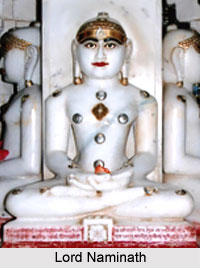 Lord Naminatha was the twenty-first Jain Tirthankara of the present era. As per Jain philosophy, he became a siddha, an enlightened soul which has demolished all of its karma.
Lord Naminatha was the twenty-first Jain Tirthankara of the present era. As per Jain philosophy, he became a siddha, an enlightened soul which has demolished all of its karma.
Lord Naminatha was born to Emperor Vijay Raja and Queen Vipra Rani of the Ikshvaku dynasty. They were the rulers of Mithiia at that time. His birth date is on the 8th day of Shravan Krishna in the Hindu calendar.
As per Jain custom, the soul that would one day be the Lord Naminath purified itself during its avatar as Emperor Siddharth. He was the emperor of the town of Kshambi in eastern Mhavideh. He had reincarnated as a God in the Aparajit dimension. After completing his age he later reincarnated as the child of Emperor Vijay and Queen Vipra.
Resurrection of Lord Naminatha
Lord Naminatha after completing his age later reincarnated as the child of Emperor Vijay and Queen Vipra. While the queen was pregnant she saw fourteen propitious things in her dream. When the augurs were consulted they declared that the unborn child was going to be either a Chkravarti or a Tirthankara.
Once during the time of Vipra`s pregnancy, Mithila was attacked by a group of powerful kings. Emperor Vijay who was very peace loving and did not wish to fight the war was at a loss. He wanted to find a quiet and easy solution to prevent the war. He consulted the augurs who advised him that in order to prevent the war the pregnant queen should go to the roof of the palace and look at the attacking armies. The queen followed the instructions and gave a loving glance at the large armies positioned on the fields outside the town. The aura of the pious soul in her womb of the queen had a powerful impact and it cast a pacifying spell on the attackers. The kings, who had been sure of winning the battle, surrendered and bowed before Emperor Vijay.
This incident inspired the Emperor and he named his new-born child as Naminath. The child was born on the eighth day of the dark half of the month of Srava. Naminath had a happy childhood and received all the royal pleasures but he always remained from them. Gradually when he matured, he was married and later on he was crowned as the king and given the reign of the kingdom. Naminath proved to be a loving and kind hearted king who took care of his subjects. After a long and successful reign, he became an ascetic on the ninth day of the dark half of the month of Ashadh. After nine months he achieved nirvana under a Bakul Tree in a garden near Mithila. Upon receiving Nirvana he gave his first discourse was on the subject of right perception. After a long period of religious and divine activities, he went to Sammetsikhar. There he became enlightened on the tenth day of the dark half of the month of Vaishakh.









